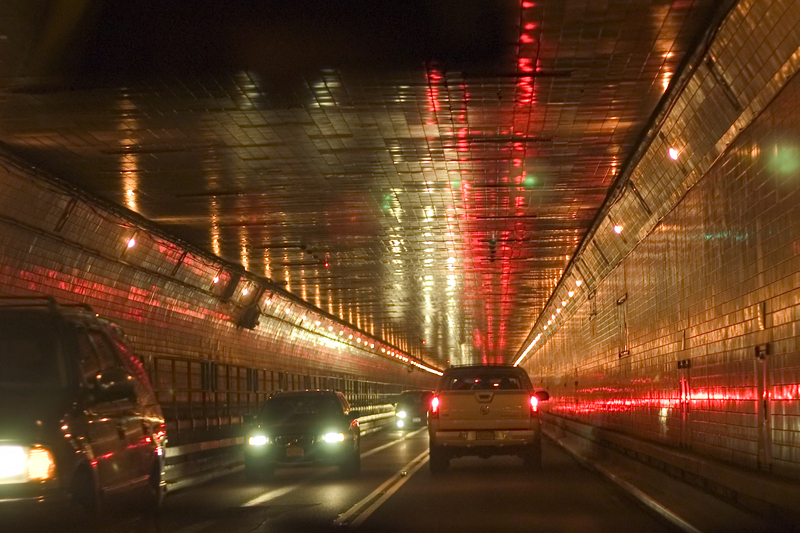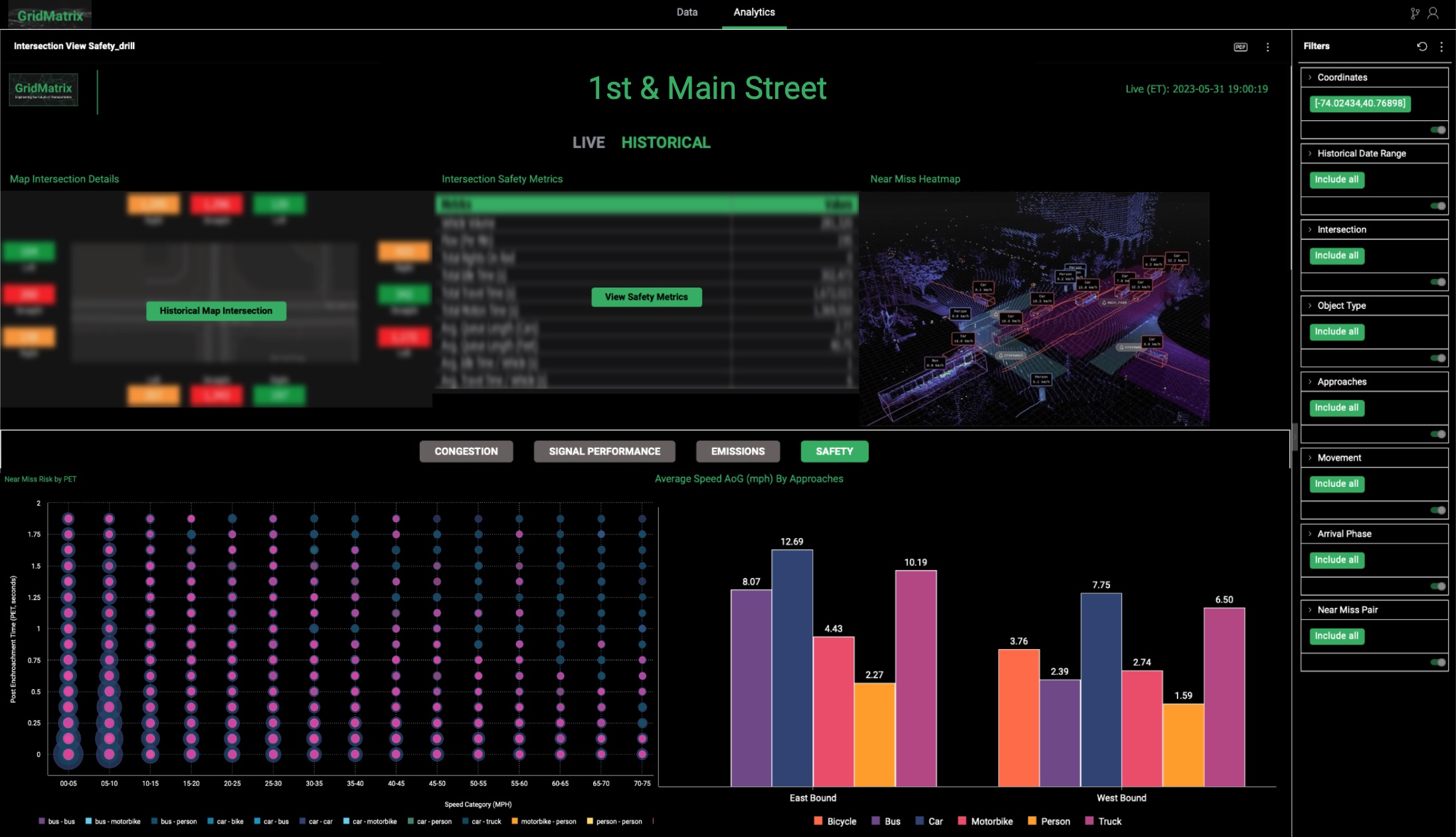
Adoption of new technology when it comes to US traffic planning has historically proceeded slowly. Often, new traffic innovations are introduced during cycles of capital investment, with the expectation no changes are needed for decades until the next investment cycle. Financial and political capital are exhausted with each upgrade, and technology is placed with the understanding that a generation may pass before a replacement.
Against this backdrop, a wave of innovation has taken place in the software field. Artificial intelligence (AI) and machine learning have made no shortage of headlines in the past few years, with some of the larger market players such as ChatGPT posing macro-level questions about the future of entire industries. It’s into this market that the Software as a Service (SaaS) transportation analytics company GridMatrix launched in 2021.
GridMatrix was conceived when the founders, including CEO and co-founder Nicholas D’Andre, were spending time abroad working in the global supply chain for his former employer, Apple. “At the time, our founding team talked a lot about how responsive the transportation systems we saw abroad were, and we started talking about how someone needed to do something to improve traffic flows in the US. We kept talking about it until ‘someone needs to do something’ became ‘let’s do something’.”
Market force
It’s difficult to define the point when a start-up transforms from a fledgling business to a mature player in a market. The process of becoming established is as much an exercise in stubborn longevity as a question of cash flow. But it’s easier to define when a company becomes a market force. Two years after its founding, GridMatrix is in the midst of just such a moment.
Since mid-April, GridMatrix has won multiple state and national contracts, including with Georgia Department of Transportation, Arizona DoT and the Purchasing Cooperative of America - an assembly of over 1,300 member governments. The company has concurrently launched or is bringing up deployments in new locations, including Peoria, Illinois; Morrisville, North Carolina; and California State University, Sacramento. GridMatrix was selected as CoMotion Miami’s M2 Challenge winner from six leading mobility technology start-ups, had its ongoing work in New York City recognised at Smart Cities Connect’s Spring conference with a Smart50 award, and launched a host of predictive safety metrics at conferences on both coasts.
“It’s been a busy spring,” says D’Andre with a smile. In addition to the new projects, the company has been focused on delivering enhanced results for existing customers, such as the Port Authority of New York and New Jersey. D’Andre, along with the company’s vice president of data science David Von Dollen and director of government affairs Kyle Pickett, recently spoke on a panel at Smart Cities Connect in Denver about the deployment – as did the Partnership for New York City’s vice president of innovation, Stacey Matlen.
“We started talking about how someone needed to do something to improve traffic flows in the US”
Nicholas D’Andre, GridMatrix

GridMatrix has been working with the Port Authority since April 2022, when its software platform was selected from over 150 start-ups globally for a proof of concept deployment in America’s biggest city. The company proposed to overlay its SaaS platform to provide transportation analytics on congestion, emissions, signal performance and safety based on the Port Authority’s existing public traffic video feeds.
The project was overseen by the Transit Innovation Partnership’s Transit Tech Lab, run by a public-private partnership between the Partnership for New York City and the Metropolitan Transportation Authority. Initially deploying its technology on the George Washington Bridge, the Port Authority subsequently invited GridMatrix to deploy its technology on additional facilities in the agency’s portfolio, including the Lincoln and Holland Tunnels for a year-long pilot that continues today. Collectively, these locations are the world’s busiest bridges and tunnels, and carry more than 180 million trips annually.
Tech stack
“The Port Authority is proud to provide opportunities for the exploration of new technology that can help people move seamlessly and safely through our facilities to keep the New York–New Jersey region moving,” says Rob Galvin, the Port Authority’s chief technology officer. “For more than 100 years, the agency has been at the forefront of technology to build infrastructure and physically make connections between people and goods, and this collaboration with GridMatrix reflects our goals to operate at the highest standards possible.”
The tech stack begins with the sensor footage, which could be a camera feed, a Lidar point-cloud, or other input methods. The raw footage is uploaded from its IP address via fibre or 5G to the AWS cloud using RTSP or similar protocols. AI and machine learning algorithms are layered over frame-by-frame on this feed to provide initial object detection. This algorithm then classifies road users into categories based on their appearance, delineating objects such as pedestrians, trucks and cars. These objects’ trajectories are calculated, and once the process is complete, the original video frame is discarded. The software retains the metadata, which then gets turned into metrics on road usage, such as post-encroachment time visualisations, carbon outputs and turn counts.
The metrics are then communicated via a user dashboard. The dashboard has two modes, one which displays a map view of the city, and which provides time-series information about an individual intersection. The city view and the intersection view are further broken down into metric classes, such as emissions, and historical versus real-time information. Each of the classes in turn contain a variety of metrics - within congestion, for example, are graphs and charts on object volume, idle time, total travel time, and average queue length, among other statistics. These can be further filtered by time, object class, movement type and approach.
All of these pieces of information offer a granular, detailed and data-rich view of each intersection in question. GridMatrix users typically analyse the data in the dashboard, but for public-facing or internal reports, users can generate .csv files, .pdfs, or use an application programming interface (API).
“We’ve been surprised by the number of governments we’ve spoken to who have specifically mentioned that they love the platform’s ability to easily generate reports,” said Pickett. “It’s a straightforward aspect of the technology, by design. But if you're used to older cameras without much in the way of software support, getting a day or a month’s worth of data in a one-click, downloadable PDF is a big leap forward.”
Early deployment
The first on-the-ground example of these findings in action came during an early deployment in which GridMatrix’s system calculated emissions at an intersection to be 50% higher by volume than the average local intersection. The culprit was a left-hand turn which was running simultaneously with a crosswalk in a heavily trafficked pedestrian zone. Left-hand turning cars often had to wait for foot traffic to reduce before they could proceed, causing emissions from idling cars to jump. After GridMatrix brought the intersection to the attention of the operations team, the light reconfiguration was able to reduce idling time by 20% and improve the traffic flow.
“GridMatrix has demonstrated how its technology is uniquely positioned to provide critical insights to adapt to a changing mobility landscape,” said Matlen. “Agencies should be empowered to use new technologies to reduce staff time to collect data and improve data quality to ensure our roads are as safe, clean, and efficient as possible.”
“Almost every city we talk to has ageing infrastructure deployed somewhere that they’re not quite sure what to do with”
Kyle Pickett, GridMatrix

In tandem with the Port Authority deployment, the analytics platform was updated earlier this year to grow the system’s safety features. After the algorithm calculates post-encroachment time and time-to-collision data, GridMatrix’s software creates a heat map for near-misses, which can help traffic engineers identify particularly dangerous hot spots. Similarly, GridMatrix developed real-time alerts for a range of unusual road activities. These can be pre-set scenarios, such as an auto-alert for accidents, or customised, such as alerting for pedestrian incursion into a vehicle-only area, or congestion levels surpassing a defined value.
GridMatrix’s work with some of its customers have faced technical challenges. Foremost among them was the layering of detection software onto very low resolution video feeds, some as low as 240P resolution. GridMatrix’s engineering team confronted the challenge head-on, improving the initial accuracy of metrics derived from these low-resolution sensors to levels approaching 90%. To understand how technically challenging these accuracy levels are to achieve, consider that a 720P camera feed has more than 10x the number of pixels as a 240P camera, while a 1080P HD camera has more than 24x the number of pixels. By achieving high accuracy levels approaching those derived from higher quality feeds, GridMatrix created a new approach to the traffic analytics market. It's here - in the utilisation of existing, low-fidelity sensors - where GridMatrix is attempting to change the rules of the ITS market.
Useful life
“It’s easy to recognise the value of data generated by modern, 1080P cameras or cutting-edge sensors like Lidar,” said D’Andre. “But most cities don’t have the budgets to stay on top of new hardware releases or an appetite to deploy and maintain them at scale. Cities make do with what they have, which is critical especially when you consider the useful life of some of these systems.”

As an example of legacy infrastructure, D’Andre cited downtown Atlanta, which he noted still has cameras running that were installed to manage traffic for the 1996 Olympics. He said that the use of sensors like these as ITS inputs provides a path for cities to see faster returns on investment. “In the process of capturing data and processing data generated from already-installed, legacy sensors, we were able to show that useful transportation data can be immediately activated for cities that thought collecting this kind of information would require an enormous amount of time and capital investment,” he says.
Therefore, rather than being markers of the past, old and under-utilised cameras, radar, and inductive loops can be as much a part of the future of transportation innovation as newly-purchased and -installed sensors. Indeed, in a world where any sensor is a potential input source, even modern camera technology can find itself taking on an unexpected second life. Camera software is typically siloed by brand and hardware type, limiting communication. By consolidating metrics from different generations, brands, and types of sensors, GridMatrix aims to offer traffic engineers a cross-sensor view of the city.
Predictive capabilities
The strategy of integrating existing sensors into the ITS ecosystem has already started to pay dividends for GridMatrix. “Hardware procurement has a long timeline, a high cost and requires shutting down pieces of infrastructure temporarily,” said Pickett. “For a lot of cities, adding another sensor at the same intersection is too redundant and costly to justify. Conversely, almost every city we talk to has ageing infrastructure deployed somewhere that they’re not quite sure what to do with.”
Pickett believes that the data from these sensors has largely been an undervalued resource in the ITS market. “Turning older assets into smart hardware, at a low price point, and on a positively turnkey timeline compared to the alternatives, has generated a lot of interest among the governments with whom we’ve spoken.”
The potential for software-based infrastructure upgrades is particularly high because of its ability to iterate quickly. “GridMatrix’s software is constantly being updated with new features,” said D’Andre. “As our deployments grow in scale to cover cities and regions, we’ll be targeting an increase in our predictive capabilities to help large-scale traffic management.”
D’Andre expects that software’s ability to adapt quickly will ultimately prove the key to hastening the pace of ITS implementation across the US. “Upgrades are integrated for users as part of their subscription,” he explains, meaning that while GridMatrix “offers an immediate boost in capabilities for users, it also provides cities with a fast-track to new capabilities outside of the decades-long upgrade cycle”.
ABOUT THE AUTHOR:
Gordon Feller is on the advisory board of GridMatrix





